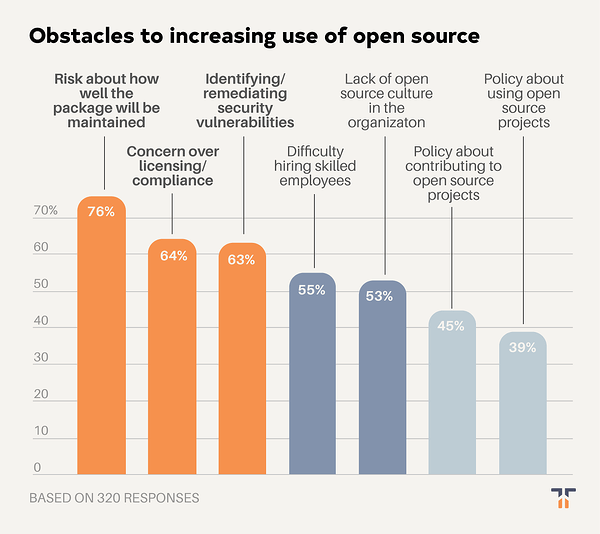In June of 2019, Tidelift and The New Stack jointly fielded a survey of professional software developers. Almost 400 people responded with thoughts about how they use open source software today, what holds them back, and what tools and strategies would help them use it even more effectively. In particular, with this survey, we were interested in learning how a managed open source strategy might help developers reclaim time, speed up development, and reduce risk.
In this post, we share the second of eight key findings. If you don’t wait to wait for the rest of the results, you can download the full survey report right now at the link below.
Finding #2: Developers’ biggest concern with open source is risk regarding how well projects will be maintained into the future.
In this survey, we asked developers to what degree a set of commonly described issues prevents them from expanding the use of open source in their organizations. Of the issues we highlighted, the most pressing fall into the categories of maintenance, security, culture, and licensing.

Perhaps the clearest finding from this question is that 46% of respondents indicated risk about how well packages will be maintained into the future is either a major or a moderate obstacle, with another 30% indicating that it is a minor obstacle. Only 18% said that this is not an obstacle for them at all.
Forty-six percent of respondents indicated risk about how well packages will be maintained into the future is either a major or a moderate obstacle, with another 30% indicating that it is a minor obstacle.
The next most pressing issue stopping developers from expanding their use of open source is concern about identifying and remediating security vulnerabilities. More than one-third, or 37% of respondents, indicated that this is either a major or moderate obstacle, with another 25% considering it a minor obstacle.
The findings regarding issues with licensing and compliance match the results from our previous surveys, where some organizations view this as a critical obstacle, while others see it as minor. This issue comes in second to maintenance risk as an identified obstacle, but 30% of respondents only consider it a minor obstacle, so just not as urgent as many as the other issues highlighted above.
The most mixed response is around the issue of open source culture in the organization. Many people—43% of respondents—do not see this as an issue at all, but 53% think it’s an obstacle to some degree. This finding shows that many organizations have embraced an open source-friendly culture and are reaping the benefits, while others are left behind.
The findings from this question highlight the opportunity for open source to develop new strategies like managed open source to reduce maintenance, security and licensing risk. Companies such as Red Hat, Elastic, and Cloudera recognized long ago that the way to help businesses deploy open source technologies successfully was to make promises about the future that were worth paying for in these three areas. Making these same assurances available not just for operating systems and data stores—but for the vast array of open source components used by application developers—represents one of the most promising opportunities for commercial open source.
Click here for the Finding #1 in this series: Despite its overwhelming advantages, open source adoption is inhibited by concerns about the availability of reliable support. Want the full survey results in one report? Get them here now.


 50 Milk St, 16th Floor, Boston, MA 02109
50 Milk St, 16th Floor, Boston, MA 02109